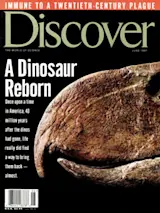Over the last decade or so, astronomers have come to an unsettling realization: they don’t know what at least 90 percent of the universe is made of. From observing clusters of galaxies, astronomers know that the gravitational pull of visible matter can’t account for all the motions they see within the clusters. Thus some type of matter they can’t see--called dark matter--must be out there. Tony Tyson, an astronomer at Bell Labs in Murray Hill, New Jersey, recently made the first detailed map of dark matter’s distribution within a cluster of galaxies. His map may not reveal what dark matter is, but at least it may show what it’s not.
To make his map, Tyson used a sort of cosmic telescope with a lens more than a million light-years across. We used the Hubble Space Telescope as the eyepiece of a very large telescope, says Tyson, in which the objective lens is the gravitational lensing of a cluster of galaxies. A gravitational lens consists of a large mass that bends any light traveling near it. When the geometry is just right, such a lens can produce several distorted images of a single galaxy behind the lens.
The best example of this is the lensing effect of a cluster of galaxies called cloo24+1654, some 2 billion light-years away. It causes us to see eight images of one galaxy that lies more than 3 billion light-years behind the cluster. With the Hubble, Tyson obtained a detailed image of this cluster and galaxy. Then, with Bell Labs colleagues Greg Kochanski and Ian Dell’Antonio, he computed the mass distribution in the cluster that would best account for various distortions in the multiple images of the lensed galaxy.
The result maps out the matter--both light and dark --in the form of a three-dimensional relief map. Dark matter around individual galaxies appears as sharp peaks. Most of the mass consists of a swell of dark matter rising up in the center of the cluster. Tyson says the map rules out dark matter candidates that can’t conform to the peculiar mass distribution he has found. Some theorists, for example, have proposed that energetic particles called neutrinos, which may have a slight amount of mass, could be important components of dark matter. Tyson says these would be evenly spread out in a cluster of galaxies and wouldn’t clump around individual galaxies in the way his map shows.
Tyson’s map also has bearing on debates about the ultimate fate of the universe. Will it expand forever, or is there enough matter to slow and reverse the expansion? If the dark matter he has mapped is typical of all clusters, then the universe will keep on expanding. The dark matter dominates the stuff that’s glowing, says Tyson, and if this is all there is, then the universe is open.














